
Ahimsa Campos-Arceiz and the Department of Wildlife and National Parks fitting a GPS-collar to study the movements of a wild elephant. Photo courtesy of Ahimsa Campos-Arceiz.
Humans and elephants have a lot in common: both are highly intelligent, intensely social, and both are capable of having a massive impact on their local environments. Given their similarities, it might not be surprising that elephants and human have often run afoul of one another. Conflict between these two great species has probably been going on for thousands of years, but as human populations have grown dramatically, elephant populations have been crippled and forced into smaller-and-smaller pockets. No-where is this more true than in Southeast Asia.
“Asian elephants occur in countries with some of the highest human densities in the world and most of their populations interact with people to some degree,” explains Ahimsa Campos-Arceiz, an elephant expert with the The University of Nottingham Malaysia Campus, in a recent interview with mongabay.com. “Almost all elephant management done now across the region is not really to conserve elephants but to mitigate the impact of the conflict on people.”
Concern over elephant survival in Malaysia led Campos-Arceiz to kick-start the Management & Ecology of Malaysian Elephants (MEME) program, which is devoted to closely studying elephant behavior in order to better mitigate conflict between local farmers and Malaysia’s peninsular elephants (see video at the end of the article). The program is devoted to “evidence-based” solutions and is a joint initiative with the Malaysian Department of Wildlife and National Parks to better manage the nation’s biggest animal.
 Timber-Latex Clon rubber plantation recently established inside a Permanent Forest Reserve. In Malaysia rubber plantations are classified as ‘forest’, though they are a monoculture, so they can be grown even inside protected areas. Photo courtesy of Ahimsa Campos-Arceiz. |
“Malaysian elephants represent a small subset of an already small global population, perhaps 3-5% of all wild Asian elephants, but they are one of the strongholds of wild elephants in Southeast Asia,” Campos-Arceiz says. “Taman Negara National Park, with 4,343 square kilometers and an estimated population of around 600 elephants, is the largest elephant population in the region.”
Although Asian elephants (Elephas maximus) are often thought of as forest animals, Campos-Arceiz says they actually prefer transition zones between primary forest and savannah.
“Elephants can do surprisingly well in disturbed environments such as secondary or selectively-logged forests. They also do very well in traditional agricultural landscapes, especially where slash-and-burn cultivation results in a mosaic of crops and secondary forest patches at different stages of regeneration,” Campos-Arceiz says, adding that, “Intensive agriculture and elephants are not compatible.”
The elephants preference for mosaic forests has placed them in a perfect situation to run into humans, and living with elephants is not easy for many locals. Known to raid crops for food, elephants are capable of significant damage—and preventing a 5 ton male elephant from doing what it wants is difficult at best. Questionnaires by MEME have found that farmers rate elephants as the number two most troublesome animal, after wild boar.
“In Malaysia, the [human-elephant] conflict has a very high economic cost (millions of dollars annually). This results in multitude of complaints by farmers and a very high and negative profile on the media, that is why the government is so active on elephant management,” Campos Arceiz notes, though he adds that elephant damage may be overblown.
“One of our objectives in MEME is to understand the economic impact of elephant crop raiding—we are particularly interested in the discrepancy between the real and the perceived impact. My own impression is that the relative economic impact per household is relatively low (Malaysian farmers are quite well off compared with those in other Asian countries) but tolerance to crop losses is also very low.”
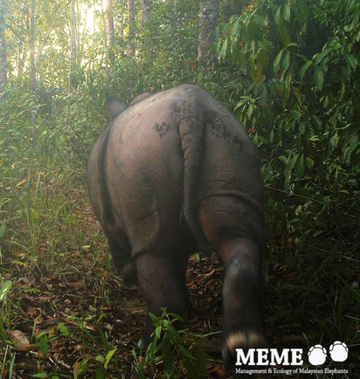 Sumatran rhino in Indonesia. Mainland Southeast Asia may have lost all its rhinos. Will elephants be next? Photo by: Deden Jaya Sutisna, Firmann Aldy, Kim McConkey, and Ahimsa Campos-Arceiz. |
Campos-Arceiz admits that there is no quick fix to halting elephant-human conflict; however, education, fencing, compensation for damage, and simple tolerance could go a long way in carving out a space for Malaysia’s elephants in a human world.
“If farmers are not willing to tolerate the presence of elephants, there is no future for them in Asia,” Campos-Arceiz says.
Mainland Southeast Asia is already near losing one of its notable megafauna: rhinos. Last year, the Javan rhino (Rhinoceros sondaicus) was announced extinct in Vietnam, its final stand in a region where it once roamed from the shores of the South China Sea to India. It still survives today in Indonesia. Meanwhile the Sumatran rhino may only survive on the mainland in a couple parks in Malaysia, but their presence has not been recently verified. If Asian elephants, which are listed as Endangered by the IUCN Red List, are to survive in Southeast Asia, mitigating human-elephant conflict is a top priority.
In a September 2012 interview, Ahimsa Campos-Arceiz discusses using evidence-based research to better manage elephants in Malaysia, mitigating conflict between humans and elephants, the massive herbivore’s importance as seed dispersers, and the possibility of one day re-wilding parts of Malaysia with elephants and rhinos.
INTERVIEW WITH AHIMSA CAMPOS-ARCEIZ
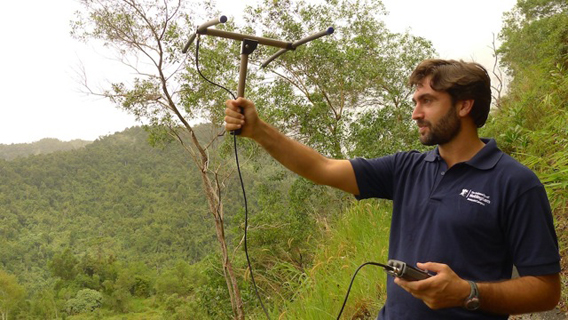
Campos-Arceiz radio-tracking elephants in Belum-Temengor Forest Complex, Malaysia. Photo courtesy of Ahimsa Campos-Arceiz.
Mongabay: What’s your background? How did you become interested in elephants?
Ahimsa Campos-Arceiz: I am a conservation ecologist with a keen interest in Asian megafauna, mainly elephants but also rhinos and tapirs. I am from Spain but have been living and working in Asia for one decade now. I became interested in elephants when I began to study them—very much by chance—in Sri Lanka, back in 2004. Elephants are magnificent, intelligent, and highly social, they play key roles in ecosystem processes and have extremely complex relationships with people—they are just a fascinating species to work with. I’m currently living and working in Malaysia, leading a project to study Malaysian elephants.
Mongabay: What does your project the Management & Ecology of Malaysian Elephants (MEME) hope to achieve?
Ahimsa Campos-Arceiz: Malaysian elephants have been intensively managed in the past 35 years without enough data about their behavior, ecology, and relationship with people, as to make properly informed decisions. The Management & Ecology of Malaysian Elephants (MEME) is a research project that aims to bring an evidence-based approach to the conservation of elephants in Peninsular Malaysia. Specifically, our objectives are to gather data to aid Malaysian authorities to make informed elephant management decisions; work with Malaysian authorities to develop a long-term and scientifically-sound elephant conservation plan; and, finally, build capacity in the field of wildlife management and conservation. The project is based at the University of Nottingham Malaysia Campus, where I work, and we work in partnership with the Malaysian Department of Wildlife and National Parks as well as other academic institutions. Our activities include studying elephant spatial ecology (particularly their movements in relation to translocation and habitat fragmentation), developing molecular tools to the study of elephants in tropical forests, studying ways to mitigate human-elephant conflict, and studying the ecological function of elephants in Malaysian rainforests. More information about the project can be found at www.meme-elephants.org.
Mongabay: Why are Malaysia’s peninsular elephants important?
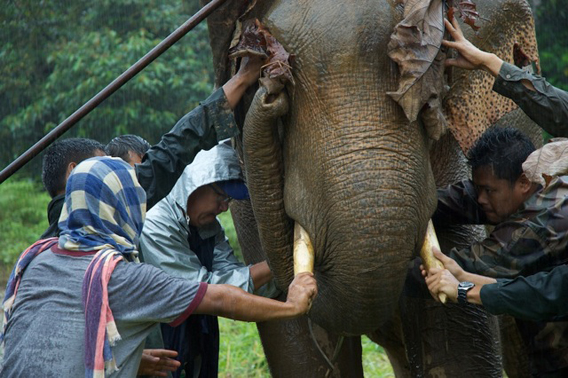
MEME’s Steven Lim and the Department of Wildlife and National Parks fitting a GPS-collar to study the movements of a wild elephant. Photo courtesy of Ahimsa Campos-Arceiz.
Ahimsa Campos-Arceiz: Asian elephants are endangered and therefore their conservation is important. Moreover, because elephants play a major role in many ecosystem processes, their conservation is also important for the functional integrity of the ecosystems they inhabit. Malaysian elephants represent a small subset of an already small global population, perhaps 3-5% of all wild Asian elephants, but they are one of the strongholds of wild elephants in Southeast Asia. Taman Negara National Park, with 4,343 square kilometers and an estimated population of around 600 elephants, is the largest elephant population in the region.
Mongabay: What are the major threats to elephants in the region?
Ahimsa Campos-Arceiz: The major threat for elephants in Southeast Asia is the interaction between deforestation and human-elephant conflict (HEC). In the past couple of decades, Indonesia and Malaysia had the highest deforestation rates in the tropics and this has had a huge impact on wildlife populations. Sumatran elephants, for example, were declared Critically Endangered by the IUCN just a few months ago. As elephant habitat is replaced by human development, this leads to an increased contact with people, normally in the form of conflict (i.e. crop raiding by elephants; elephant harassment by people). Gradually, HEC becomes more intense and eventually elephants disappear from the landscape. Poaching and live-capture for trade are also important threats in some parts of Southeast Asia but not really in Malaysia; at least not now.
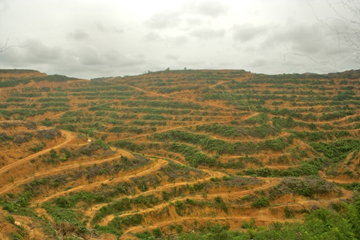 Habitat loss is a significant threat to elephants in mainland Malaysia. Here prime elephant habitat was replaced by an oil plantation near Taman Negara National Park. Photo courtesy of Ahimsa Campos-Arceiz. |
Mongabay: How is MEME hoping to link conservation science with on-the-ground conservation work, two fields that sometimes, unfortunately, feel miles apart?
Ahimsa Campos-Arceiz: You are right that theory and practice are often too far apart. MEME started as a university-based project but after the recent signing of a Memorandum of Understanding (MOU), it has become a joint-venture with the Department of Wildlife and National Parks of Peninsular Malaysia. The researchers do the science and the government agency does the management. We try to target questions that are relevant for management, e.g. what happens with translocated elephants? what kind of electric fences are effective and where? what is the effect of roads as barriers for elephant movement? where do elephants cross roads? Hopefully, this partnership will lead to a more effective conservation of Malaysian elephants.
We also try to understand local communities and work with them. Elephant conservation in Malaysia is as much about dealing with people as it is about dealing with elephants. Besides studies on farmers’ perceptions of elephants and HEC, we also do outreach activities—e.g. we publish a newsletter describing our activities and the importance of doing conservation science, we contribute articles in general and specialized media in Malaysia, and we do talks for schools, universities, government agencies, open audiences, etc.
Finally, as a university-based project, a big part of our work is training the next generation of elephant managers and researchers in Malaysia. We provide PhD scholarships to students that one day, we hope, will be leading elephant conservation in the country.
COLLARING AND CONFLICT
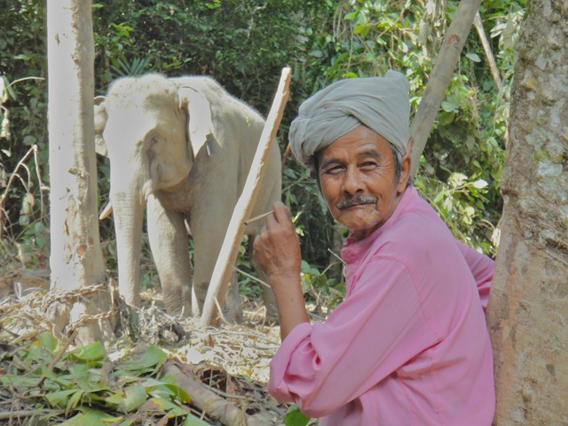
Malaysian villager with elephant behind him. Photo courtesy of Ahimsa Campos-Arceiz.
Mongabay: You’ve been collaring elephants now for over a year in order to track them. What can you tell us about your findings?
Ahimsa Campos-Arceiz: We have been using GPS-collars to track elephant movements in Malaysia since March 2011. It is still early to draw strong conclusions from our data due to the small sample size but we are finding a number of interesting behaviors. For example, some translocated elephants are able to navigate back to their native homes in quite straight lines for distances of more than 70 kilometers. We are also finding that bulls in highly fragmented landscapes can have really tiny home ranges, although we do not know whether one day they will just make a long distance move to some other areas. We are also finding interesting reactions of elephants to roads, definitely very different to what researchers like Steven Blake have found in African forest elephants.
Mongabay: How do the elephants react to loss of forest and human areas?
Ahimsa Campos-Arceiz: Elephant reaction to forest loss is very complex and non-linear. In simple words, they react well to a little of forest loss but they cannot cope with severe losses. Ecologically, elephants are edge specialists—against what many people believe, elephants’ preferred habitat is not pristine forest but the interface between forest and open areas, where food resources for a herbivore are more abundant. Given this, elephants can do surprisingly well in disturbed environments such as secondary or selectively-logged forests. They also do very well in traditional agricultural landscapes, especially where slash-and-burn cultivation results in a mosaic of crops and secondary forest patches at different stages of regeneration. In places like southeastern Sri Lanka there are more elephants in agricultural landscapes than deep into the fully protected forests of Yala National Park. Further forest losses are generally associated with an intensification of agriculture and increase in human population. As this happens, human-elephant conflict escalates to the point in which elephants are eventually removed from the area (either they are displaced to contiguous areas or die for different reasons). Intensive agriculture and elephants are not compatible.
Mongabay: Are elephants able to migrate after the forests have been lost?
Ahimsa Campos-Arceiz: Migration is not common in Asian elephants. There might be some populations in India that undergo long-distance seasonal movements but most GPS-tracking studies have shown that Asian elephants do not migrate, they just have very large home ranges. Fragmentation of elephant home ranges is certainly a problem and something that leads to increased levels of human-elephant conflict. We are currently studying the fragmentation effect of roads on elephants living in Belum-Temengor Forest Complex, a large patch of forest bisected by a road in northern Peninsular Malaysia.
Mongabay: How significant is human-elephant conflict in the region?
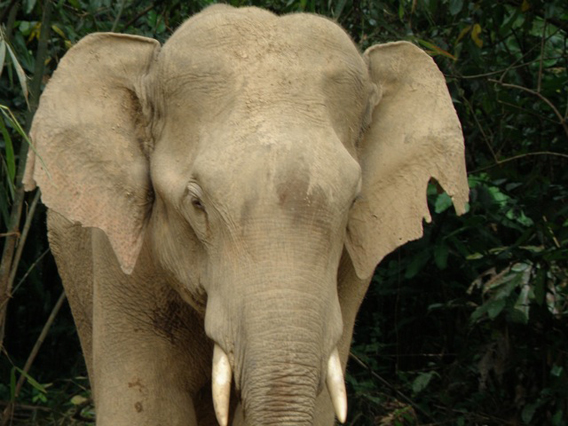
Jerek, one of MEME’s collared elephants. Photo courtesy of Ahimsa Campos-Arceiz.
Ahimsa Campos-Arceiz: Human-elephant conflict is extremely important in Asia, both for elephants and for people living in elephant range. Asian elephants occur in countries with some of the highest human densities in the world and most of their populations interact with people to some degree. Almost all elephant management done now across the region is not really to conserve elephants but to mitigate the impact of the conflict on people. The intensity of the conflict is also very variable. In countries like India and Sri Lanka many people and elephants are killed every year as a consequence of human-elephant conflict (e.g. as many as 400 people and 200 elephants per year in India), while in other places the conflict is largely a problem of economic losses produced by crop raiding (e.g. Malaysia, China).
In Malaysia, the conflict has a very high economic cost (millions of dollars annually). This results in multitude of complaints by farmers and a very high and negative profile on the media, that is why the government is so active on elephant management. One of our objectives in MEME is to understand the economic impact of elephant crop raiding—we are particularly interested in the discrepancy between the real and the perceived impact. My own impression is that the relative economic impact per household is relatively low (Malaysian farmers are quite well off compared with those in other Asian countries) but tolerance to crop losses is also very low. I think we might be able to increase this tolerance through improved mitigation policies, awareness campaigns, and in some cases economic compensation schemes.
Currently I am offering a fully-funded PhD scholarship at the University of Nottingham Malaysia Campus to Malaysian candidates interested in studying HEC. Interested candidates (need to be Malaysians) can contact me for more details.
Mongabay: What are some solutions to this problem?
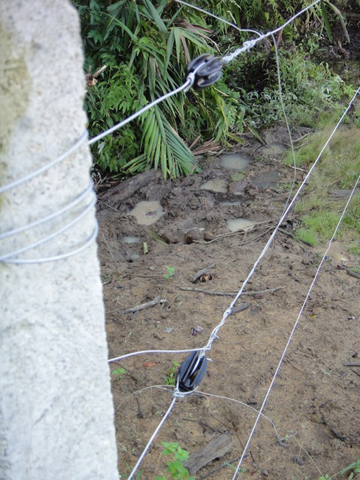 An electric fence in Johor, southern Peninsular Malaysia with elephant dung and footprints on the other side of the fence. Photo courtesy of Ahimsa Campos-Arceiz. |
Ahimsa Campos-Arceiz: The general agreement is that there is no ‘solution’ to human-elephant conflict other than removing either elephants or people. The best option is try to ‘mitigate’ its effects and, again, there is no silver bullet for this. What we would like to do in Malaysia is working in two directions: first, taking measures to reduce the damage caused by elephants by improving the protection of crops (e.g. using electric fences, avoiding new plantations in HEC-prone areas, etc); and second, increasing people’s tolerance to elephants and HEC using a combination of awareness and compensation programs. To achieve this we need to understand the elephant dimensions of the conflict (what crops elephants raid? when and where they do it? which elephants engage in crop raiding? why they do it?) as well as the human dimensions (how important is HEC’s impact on people’s livelihood and how important they perceive it is? what is the current tolerance level to elephants, what factors affect this level, and how can we increase it?).
Mongabay: What role does education play in mitigating this conflict?
Ahimsa Campos-Arceiz: It plays a very important role because it can help increase people’s tolerance to elephants and HEC. If farmers are not willing to tolerate the presence of elephants, there is no future for them in Asia. It also plays a role to engage urban population not directly affected by HEC but who indirectly benefit from conserving elephants (e.g. through ecotourism or for aesthetic, cultural, or religious reasons). Education can involve city dwellers in elephant conservation activities, such as raising funds to build electric fences or to pay insurance schemes, as recently shown in a neat study by Shu Chen, a Chinese researcher.
Mongabay: Did you have any surprises in your community surveys on attitudes to elephants?
Ahimsa Campos-Arceiz: We had some interesting results. For example, elephants were rated as the second most problematic animal for farmers in Malaysia, after wild boar. Farmers seemed really unaware of crop losses produced by small animals (invertebrates, rodents) and other factors (diseases, weather). I found particularly interesting that they consider that the only responsibility to deal with HEC is the government, apparently not assuming any responsibility themselves. This is very important because we believe that farmers need to bear part of the responsibility of mitigating the conflict—if they are going to have a plantation in an elephant area, they need to take elephants into consideration (e.g. planning fences and tolerating some crop losses). In spite of this, farmers show willingness to contribute to HEC mitigation through in-kind contributions, so it is possible to work with communities to take some coordinated measures such as the construction and maintenance of electric fences. This is a huge amount of work however. Maybe an area where NGOs can work with the communities.
Most of our HEC perception work was conducted in the frame of the Elephant Conservation Group (ECG) a network of human-elephant conflict projects across seven Asian countries. We conducted the same questionnaire in all these countries and are now analyzing the data.
Mongabay: Tell us about ‘conservation drones’? What role could these play in safeguarding elephants?
Ahimsa Campos-Arceiz: Mongabay readers probably know well about Conservation Drones, since they have been featured a couple of times in this blog. They are an initiative from Drs Lian Pin Koh & Serge Wich to develop cost-effective Unmanned Aerial Vehicles (UAV) that can be used to collect information for conservation studies. We are currently exploring the possibilities of using conservation drones to study elephant habitat (they allow us to take very good aerial photography) as well as the social behavior of our collared elephants (e.g. from the collar we know where they are but not whether they are alone or in groups). There is a fantastic potential in these drones and maybe one day we can use them for things as diverse as monitoring breaches in electric fences, patrolling for poachers, or studying fruit phenology in the forest canopy.
SEED DISPERSAL BY MEGAFAUNA

Sumatran rhino in Indonesia. A few individuals of Sumatran rhino may still persist on mainland Malaysia as well. Photo by: Deden Jaya Sutisna, Firmann Aldy, Kim McConkey, and Ahimsa Campos-Arceiz.
Mongabay: You’ve studied seed dispersal of Asian elephants in depth. What role do these animals play in keep Southeast Asia forests healthy?
Ahimsa Campos-Arceiz: Elephants play very important roles in ecosystem processes and seed dispersal is an excellent example—elephants can disperse large amounts of seeds, of potentially very large size, from a high diversity of plant species, over long distances, and deposit them in conditions that promote germination and the survival of the plant. All these factors (number of seeds dispersed, seed size, dispersal distance, and deposition pattern) are very important for the plant, while the diversity of plants dispersed and dispersal distance, are very important for the plant community. All in all, elephants are very effective seed dispersers and play an important role in shaping the structure and promoting the regeneration and conservation of tropical forests.
Mongabay: When it comes to seed dispersal is the abundance of elephants important? In other words, even when elephant are still present in Asian forests their populations are often very low. How could this impact dispersal and the forest structure?
Ahimsa Campos-Arceiz: Elephant density is important but I’m not aware of any study that has specifically addressed it. The most obvious effect of elephant density is on the number of seeds they can disperse. At very low elephant densities, many large-seeded fruits will never be found by an elephant and thus they won’t be dispersed over long distances. Many of these seeds will rot under the mother tree, others will be killed by seed predators, and yet others might be dispersed over short distances by smaller dispersers (e.g. see the great study by Jansen et al. 2012 about agouties in Panama). In Malaysia we are finding that many large fruits not consumed by elephants are removed and transported by porcupines and rats. We still don’t know how far they are transported and whether any of these seeds manages to survive and establish. Overall, we can expect a drastic reduction in dispersal distances and seed rain for most of plant individuals and, thus, a reduction in recruitment success and an increase in population structure—clear signs of dispersal limitation.
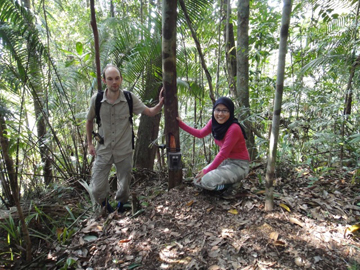 Deploying a camera trap to study frugivory by Asian elephants. Photo courtesy of Ahimsa Campos-Arceiz. |
Low animal densities can lead to changes in behavior that affect their role as seed dispersers. Kim McConkey found that flying foxes at low density are not effective dispersers for large-seeds because they consume and drop them at the mother tree. At high density, on the other hand, the flying foxes grab the fruits and fly away to consume them elsewhere, thus providing a good dispersal. Maybe something similar happens with elephants.
Something somehow related is that, in the absence of hunting, the high or low density of elephants is related to habitat factors so I expect high elephant densities in disturbed or open habitats and very low in primary forests. In disturbed areas, elephants will consume and disperse many seeds of pioneer and exotic plant species, thus playing a less important and even a negative ecological function. In primary forests, elephants are likely to disperse more seeds of old-growth specialist plants, often of large-size, thus playing a very important—specialized and positive—role in the maintenance of the forest.
Mongabay: Given that rhinos may well be extinct in Peninsular Malaysia (or at least occur in incredibly low populations) will elephants make-up for them in dispersing seeds or do the species spread different seeds?
Ahimsa Campos-Arceiz: I guess elephants disperse most of the seeds dispersed by rhinos, but not the other way around, so probably yes— elephants are likely to maintain seed dispersal function in the absence of rhinos
Although there are differences in the way elephants and rhinos deposit seeds (e.g. rhinos are prone to the use of latrines), I expect elephants to disperse most of the seeds dispersed by rhinos and thus being able to make-up for much of the function lost with rhinos. But rhinos do much more than dispersing seeds and other ecosystem functions such as the creation of wallows (important for many invertebrates and amphibians) or other forms of habitat disturbance will be lost in their absence. As you say, Sumatran and Javan rhinos are just one step away from extinction and I think it is important to understand their role in ecosystem processes to understand the consequences of losing them.
Mongabay: Is reintroduction a possibility for elephants or rhinos in areas where they are either lost or nearly gone in Peninsular Malaysia?
Ahimsa Campos-Arceiz: In my opinion, megafaunal reintroductions are possible and desirable, but they need to be planned and implemented very carefully. Otherwise, these programs might backfire and have negative impacts on conservation. In the near future, I hope to see the footprints of elephants and rhinos in the Malaysian forests where we haven’t seen them for some time (e.g. Krau in the case of elephants, Taman Negara and Belum in the case of rhinos).

Elephant translocation operation by the Malaysian Department of Wildlife and National Parks. Photo courtesy of Ahimsa Campos-Arceiz.
![]()
MEME’s Steven Lim and the Department of Wildlife and National Parks using a VHF receiver to track the movements of a collared elephant. Photo courtesy of Ahimsa Campos-Arceiz.
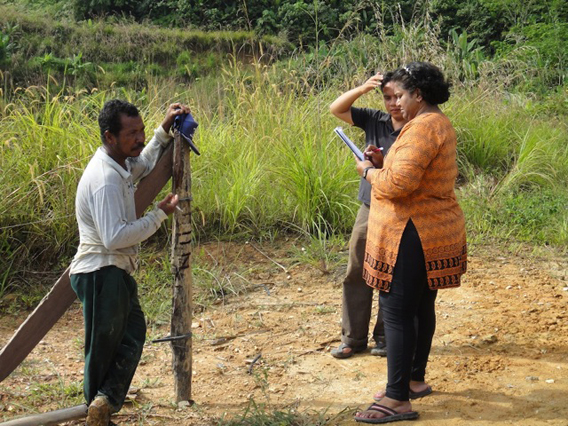
MEME’s Vanitha Ponnusamy conducting questionnaires about farmer perceptions on human-elephant conflict. Photo courtesy of Ahimsa Campos-Arceiz.

MEME’s Wong Ee Phin (PhD candidate) setting up a field lab to study elephant hormones. Photo courtesy of Ahimsa Campos-Arceiz.
Related articles
Tracking elephants in Cameroon to mitigate conflict with locals
(07/09/2012) Elephant conservation is imperiled by poor spatial planning, according to a new study in mongabay.com’s open access journal Tropical Conservation Science. Tracking two elephant matriarchs in and around Bénoué National Park in Cameroon, scientists found that the herds spent over half their time outside of the park, highlighting the potential for human-wildlife conflict as elephants are known to raid fields.
Wildlife trade bans may be worsening trafficking of some species, argues paper
(09/18/2012) While founded with good intentions, wildlife trade bans may in some cases be worsening the plight of some endangered species, argues a commentary published in the journal Tropical Conservation Science.
Religious fervor drives elephant slaughter
(09/14/2012) The legal ivory trade is failing to protect elephants which are being slaughtered en mass across the African continent to meet demand for religious trinkets, argues a new investigative report published in National Geographic by Bryan Christy.
Yuppies are killing rhinos, tigers, elephants
(09/07/2012) Yuppies, not elderly rural consumer, are driving the trade that is decimating some of the world’s most iconic endangered species, including tigers, elephants, rhinos, pangolins, and bears, said experts meeting at a workshop in Vietnam.
Elephant numbers halved in Central Africa in 5 years
(06/08/2012) Elephant numbers in areas surveyed by the Wildlife Conservation Society (WCS) in Central Africa halved between 2006 and 2011, hinting at the carnage wrought by the surging commercial ivory trade and demonstrating a need to boost protection efforts, said the Bronx Zoo-based conservation group.
3 elephants killed on Indonesian oil palm plantation in Sumatra
(06/01/2012) Three critically endangered Sumatran elephants were poisoned to death within an palm oil plantation on the island of Sumatra, reports the Associated Press.
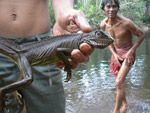
(05/03/2012) Abandoned by NGOs and the World Bank, carved out for rubber plantations and mining by the Cambodian government, spiraling into a chaos of poaching and illegal logging, and full of endangered species and never-explored places, Virachey National Park may be the world’s greatest park that has been written off by the international community. But a new book by explorer and PhD student, Greg McCann, hopes to change that. Entitled Called Away by a Mountain Spirit: Journey to the Green Corridor, the book highlights expeditions by McCann into parts of Virachey that have rarely been seen by outsiders and have never been explored scientifically, including rare grasslands that once housed herds of Asian elephants, guar, and Sambar deer, before poachers drove them into hiding, and faraway mountains with rumors of tigers and mainland Javan rhinos.
Camera traps discover tigers, elephants in “empty” forest park

(04/16/2012) Although it’s named Namdapha Tiger Reserve, conservationists had long feared that tigers, along with most other big mammals, were gone from the park in northeast India. However, an extensive camera trap survey has photographed not only Bengal tigers (Panthera tigris tigris), but also Asian elephants (Elephas maximus), which were also thought extirpated from the park. Once dubbed an “empty forest” due to poaching, the new survey shows that Namdapha still has massive conservation potential.
Featured video: wild Sumatran elephants on camera trap video
(04/11/2012) A video camera trap project called Eyes on Leuser has captured wonderful footage of a very curious herd of Sumatran elephants (Elephas maximus sumatranus) in the island’s Leuser ecosystem. The project has already documented a wealth of species, including imperiled and elusive animals like the Sumatran tiger, marbled cat, and white-winged duck.
What a Bornean elephant wants: more protected forests and wildlife corridors
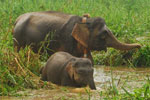
(02/16/2012) Forest fragmentation and destruction is imperiling the Bornean elephant (Elephas maximus borneensis), according to a new paper published in PLoS ONE. Using satellite collars to track the pachyderms for the first time in the Malaysian state of Sabah, scientists have found that the elephants are extremely sensitive to habitat fragmentation from palm oil plantations and logging.
Sumatran elephant population plunges; WWF calls for moratorium on deforestation
(01/24/2012) The Sumatran elephant subspecies (Elephas maximus sumatranus) was downgraded to critically endangered on IUCN’s Red List of Threatened Species on Tuesday, prompting environmental group WWF to call for an immediate moratorium on destruction of its rainforest habitat, which is being rapidly lost to oil palm estates, timber plantations for pulp and paper production, and agricultural use.